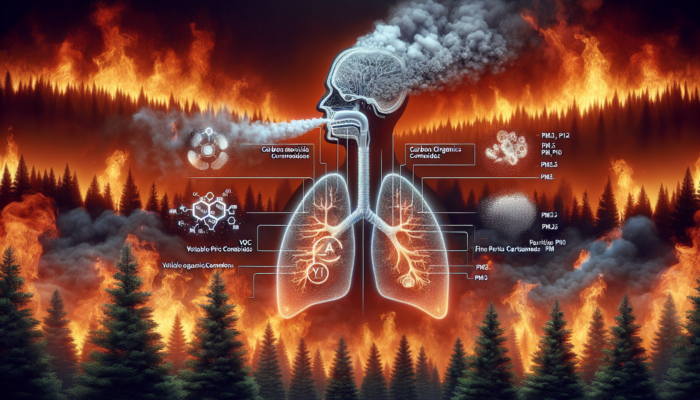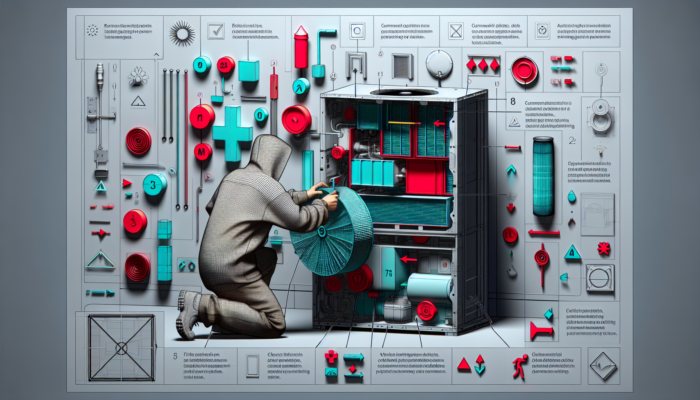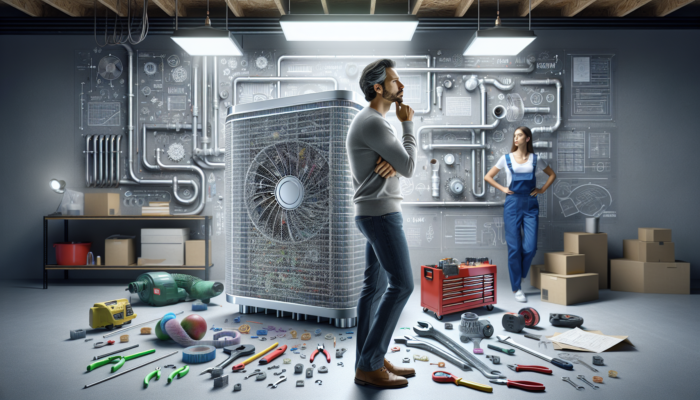Improve Your Indoor Air Quality with High-Performance Wildfire Air Filters
Investing in wildfire air filters is an essential measure for protecting your indoor environment from the harmful effects of wildfire smoke. These advanced filters are critical for maintaining superior air quality by effectively capturing toxic particulates and harmful substances that can infiltrate your home. As wildfires become increasingly prevalent due to shifts in climate, it is vital to comprehend the importance and functionality of these filters in enhancing health and safety. By prioritizing your indoor air quality, you can create a healthier and safer refuge for yourself and your family amidst the rising environmental challenges we face.
Comprehending Wildfire Smoke: Essential Elements to Filter for Optimal Air Quality

To effectively purify your indoor air, it is crucial to understand the intricate components of wildfire smoke. This smoke is a dangerous amalgamation of gases and fine particles produced during the combustion of various organic materials. It contains toxic elements, such as carbon monoxide, volatile organic compounds (VOCs), and particulate matter (PM2.5 and PM10). These tiny particles can infiltrate deep into the lungs, presenting significant health risks for anyone exposed to them.
Moreover, the organic compounds found within the smoke can include hazardous chemicals like benzene and formaldehyde, both of which are known to contribute to respiratory challenges and various health complications. Investing in high-quality wildfire air filters can dramatically diminish the presence of these dangerous substances in your home, resulting in a substantial improvement in your indoor air quality.
Identifying Health Risks: The Detrimental Effects of Wildfire Smoke on Your Health
The health dangers associated with exposure to wildfire smoke are considerable and should be taken seriously. Even brief exposure can provoke a range of symptoms, including coughing, throat irritation, and aggravation of pre-existing respiratory conditions such as asthma and chronic obstructive pulmonary disease (COPD). Extended exposure heightens the risk of developing serious health issues, including cardiovascular diseases and lung cancer.
Given the potential severity of these health risks, ensuring clean air through effective air filters is not merely a comfort issue; it is a critical component of safeguarding overall health and well-being. When smoke infiltrates your living space, utilizing a high-efficiency filtration system can significantly reduce these health hazards. The right air filter can dramatically lower the concentration of harmful airborne particles, enhancing health outcomes for you and your loved ones.
Essential Factors to Consider When Choosing the Ideal Wildfire Air Filter for Your Home
Selecting the most suitable wildfire air filter involves careful evaluation of several key factors. Initially, the filter's efficiency rating, often represented by MERV (Minimum Efficiency Reporting Value) ratings, is of utmost importance. Filters boasting a MERV rating between 13 and 16 are highly recommended for effectively capturing smoke particles and improving indoor air quality.
Additionally, it is crucial to assess the size and compatibility of the filter with your current HVAC system. Ensuring a proper fit prevents unfiltered air from bypassing the filtration system, thereby maximizing its efficiency. Furthermore, consider the filter's lifespan and maintenance requirements; some filters necessitate frequent replacements, while others are designed for prolonged use.
Lastly, evaluate any specific health concerns within your household. For example, if anyone suffers from allergies or respiratory issues, it may be wise to select a filter that captures allergens alongside smoke, offering additional protection. By thoughtfully weighing these considerations, you can make an informed choice that significantly enhances your indoor air quality.
Comprehensive Guide for Properly Installing Wildfire Air Filters

Correct installation of wildfire air filters is crucial to ensure their optimal performance. A properly installed filter not only captures airborne pollutants effectively but also enhances the overall efficiency of your HVAC system. The following sections will provide a thorough guide on the correct installation process, common pitfalls to avoid, and considerations for professional installation if required.
Step-by-Step Guide for Successfully Installing Wildfire Air Filters
Installing wildfire air filters is typically a straightforward task, but it necessitates careful attention to detail to ensure effectiveness. First, turn off your HVAC system to guarantee safety during the installation process. Locate the filter compartment, which is usually found on the return air duct or air handler. Carefully remove the old filter, noting its orientation to ensure proper placement of the new filter.
Once the old filter has been removed, thoroughly clean the compartment to eliminate any dust or debris that could impede the performance of the new filter. This step is essential for maintaining optimal air quality. When inserting the new filter, ensure that the airflow direction arrow points toward the blower, as correct orientation is vital for effective filtration. After replacing the cover, turn the system back on and pay attention to any unusual noises that might indicate improper installation.
Common Mistakes to Avoid When Installing Wildfire Air Filters
Even a seemingly simple task like installing wildfire air filters can be rife with potential errors. One common mistake is failing to verify the filter size. Using a filter that is either too small or too large can lead to air bypass, rendering the filter ineffective. Always double-check the dimensions in accordance with the specifications provided by the manufacturer.
Another frequent oversight is neglecting to clean the filter compartment prior to installation. Dust and debris accumulation can hinder the performance of the new filter. Additionally, failing to follow the manufacturer's instructions regarding airflow direction can seriously compromise the filter's efficiency. Being cognizant of these common pitfalls can help ensure that your air filtration system operates at its highest capacity.
Deciding Between DIY Installation and Seeking Professional Assistance for Wildfire Air Filters

When it comes to installing wildfire air filters, homeowners must decide whether to undertake the task themselves or hire a professional. Opting for DIY installation can be cost-effective and manageable for those who feel confident working with home systems. Many homeowners discover that adhering to manufacturer guidelines simplifies the process.
However, if your HVAC system is complicated or if you feel uncertain about the installation process, engaging a professional may be the more prudent choice. A qualified technician can ensure that the filter is installed correctly and efficiently, providing peace of mind. Ultimately, your decision should reflect your comfort level with DIY tasks and the complexity of your HVAC system.
Vital Maintenance Practices for Wildfire Air Filters to Ensure Long-Term Performance
Regular maintenance of wildfire air filters is essential for ensuring their effectiveness and longevity. Proper upkeep not only maximizes the lifespan of the filter but also guarantees that your indoor air remains clean and safe. This section will discuss the recommended frequency for filter replacements, the cleaning process versus replacement, and how to recognize when your filter requires attention.
Recommended Replacement Schedule for Wildfire Air Filters
The frequency at which you should replace wildfire air filters can vary significantly based on different factors. As a general guideline, it is advisable to change your filter every three months. However, if you reside in an area prone to wildfires or have pets and allergies, more frequent changes may be necessary to maintain optimal air quality. Monitoring the condition of your filter can help you establish the best replacement schedule tailored to your specific situation.
Some filters come equipped with indicators that alert you when they need to be replaced. If your filter appears discolored or clogged with dust, it is a clear signal that a replacement is overdue. Regular inspections of your filter can prevent reduced airflow and ensure that your HVAC system operates efficiently.
Cleaning versus Replacing: Maximizing the Lifespan of Your Wildfire Air Filter
While some wildfire air filters are designed for cleaning and reuse, others are intended for one-time use. If your filter is washable, cleaning it can significantly extend its lifespan. Use a vacuum or a soft brush to remove accumulated dust, then rinse it with water, ensuring it is completely dry before reinstalling.
However, it is essential to follow the manufacturer's cleaning instructions and frequency guidelines. Over-cleaning can damage the filter material, resulting in diminished effectiveness. For disposable filters, replacement remains the best option to ensure optimal performance and air quality.
Recognizing Signs That Your Wildfire Air Filter Requires Attention
Identifying when your wildfire air filter needs attention is crucial for maintaining air quality. Common indicators include visible dust buildup, reduced airflow from your HVAC system, and an uptick in allergy symptoms within your home. If you notice any of these warning signs, it is time to inspect your filter and consider a replacement.
Moreover, if you detect a musty or smoky odor while your HVAC system is operational, it may indicate that the filter is saturated with pollutants and is no longer functioning effectively. Regular inspections and timely replacements can help prevent these issues, ensuring your indoor air remains healthy and clean.
Evaluating the Performance and Efficiency of Wildfire Air Filters
The efficiency of wildfire air filters is paramount in combating the adverse effects of wildfire smoke. Understanding the various ratings and technologies available can assist you in selecting the most appropriate filter for your needs. This section will explore MERV ratings, the significance of HEPA filters, and insights from real-world testing results.
Understanding MERV Ratings: Choosing the Best Filter for Wildfire Smoke
The MERV rating system is crucial for assessing the effectiveness of air filters. Filters with a MERV rating of 13 or higher are generally recommended for capturing smoke particles. These filters can trap particulate matter as small as 0.3 microns, which includes many of the harmful components found in wildfire smoke.
However, it is important to recognize that higher MERV ratings often lead to increased airflow resistance. Therefore, finding a balance between the need for effective filtration and the specifications of your HVAC system is crucial. A filter with an excessively high MERV rating may restrict airflow, thereby diminishing the overall efficiency of the system. Thus, selecting a filter that aligns with your specific requirements is essential for maintaining optimal performance.
The Exceptional Effectiveness of HEPA Filters in Capturing Wildfire Particles
HEPA (High-Efficiency Particulate Air) filters are celebrated for their outstanding capacity to capture tiny particles, including those associated with wildfire smoke. These filters are engineered to trap at least 99.97% of particles that are 0.3 microns in size, making them among the most effective options available for ensuring clean air.
When searching for wildfire air filters, those featuring HEPA technology are particularly effective in mitigating the adverse impacts of smoke. Incorporating a HEPA filter into your air management system can substantially lower the concentration of harmful particulates in your indoor environment, thus promoting better health outcomes for all inhabitants.
Evaluating Real-World Testing: The Effectiveness of Wildfire Air Filters
The efficacy of wildfire air filters is often demonstrated through various real-world testing scenarios. Studies and consumer reports have shown that filters with high MERV ratings or HEPA technology can dramatically reduce particulate matter in indoor air during wildfire events. These tests confirm that selecting the appropriate filters can lower the concentration of harmful particles to safe levels, thus protecting your health.
When assessing filter performance, seeking independent testing results that validate its effectiveness is beneficial. Such information can guide you in making a well-informed decision and ensure that you choose a filter that meets your specific needs during wildfire season.
Financial Insights: Evaluating the Costs of Wildfire Air Filters
Investing in wildfire air filters can represent a significant financial commitment; however, it is essential to consider the long-term advantages of maintaining clean air. This section will analyze the cost-benefit ratio of these filters, explore budget-friendly options, and discuss potential long-term savings that can arise from healthier living conditions.
Evaluating the Cost-Benefit of Wildfire Air Filters: A Smart Investment
The initial cost of high-quality wildfire air filters may appear substantial, yet the benefits can far exceed the expenses. Improved air quality is directly linked to enhanced health, resulting in lower medical costs associated with respiratory issues and allergies. Filters that boost HVAC efficiency can also lead to reduced energy bills, thereby offsetting the initial investment.
When assessing costs, it is vital to consider not only the price of the filters but also the potential healthcare savings. By prioritizing air quality, you are investing in the long-term health of your household, making it a wise financial decision.
Affordable Wildfire Air Filters: Effective Options for Budget-Conscious Consumers
For those operating on a limited budget, many wildfire air filters offer effective filtration without overwhelming financial strain. Numerous brands provide affordable alternatives that meet quality benchmarks, allowing you to maintain clean air without overspending. Look for filters with favorable MERV ratings and positive consumer feedback to ensure you are making a prudent investment.
Additionally, consider purchasing filters in bulk or seeking out promotions and discounts through online retailers. These strategies can assist you in finding economical and efficient solutions to meet your air quality requirements.
Long-Term Savings: How Wildfire Air Filters Can Lower Healthcare Costs
Investing in wildfire air filters can yield considerable long-term savings in healthcare expenses. As respiratory diseases linked to poor air quality become increasingly prevalent, having an effective filtration system can help mitigate these dangers. Reducing exposure to harmful particulates and toxins can lessen the likelihood of medical visits, prescriptions, and hospitalizations.
Moreover, sustaining good air quality can enhance overall well-being and productivity, further contributing to the economic benefits of investing in air filters. The long-term savings associated with improved health outcomes make these filters a wise choice for any household, particularly those in wildfire-prone areas.
User Experiences: Insights and Feedback on Wildfire Air Filters
User experiences and reviews provide invaluable insights into the effectiveness of wildfire air filters. Understanding how others have benefited from these products can significantly influence your purchasing decisions. This section will highlight case studies, popular user feedback, and address common concerns regarding performance.
Real-Life Case Studies: The Transformative Benefits of Wildfire Air Filters
Numerous case studies showcase the positive effects of wildfire air filters on indoor air quality. For instance, families residing in areas affected by the California wildfires have reported marked improvements in air quality after installing high-efficiency filters. Many observed diminished allergy symptoms and respiratory issues, demonstrating the filters’ effectiveness in managing wildfire smoke.
Another notable example involves schools situated in wildfire-prone regions that implemented air filtration systems to safeguard students and staff during smoke events. Feedback from educators and parents indicated a substantial enhancement in the classroom environment, contributing to improved student focus and academic performance.
Customer Feedback: What Users Appreciate About Their Wildfire Air Filters
User reviews reveal that many individuals value the peace of mind offered by wildfire air filters. Customers frequently cite improved air quality, fewer allergic reactions, and enhanced overall health as significant benefits of their investment. The ease of installation and maintenance is also a commonly appreciated feature, with many users noting that regular filter changes are simple and manageable.
Moreover, many consumers express satisfaction with the cost-effectiveness of these filters, emphasizing the balance between price and performance as a crucial factor in their decision-making process. Such positive feedback reinforces the value of investing in high-quality air filtration systems.
Addressing User Concerns: Common Feedback on Wildfire Air Filter Performance
Despite largely positive reviews, some users have voiced concerns regarding wildfire air filters. Common issues include noise levels associated with specific models and questions about the filter's lifespan. While many filters are designed to operate quietly, some users have reported that higher MERV-rated filters may generate more noise due to increased airflow resistance.
Additionally, users often inquire about the recommended frequency for filter replacements and the associated costs. Providing clear guidance on maintenance and setting realistic expectations regarding filter longevity can help alleviate these concerns. Ultimately, user feedback is a valuable resource for prospective buyers considering wildfire air filters.
Innovations in Wildfire Air Filters: Emerging Trends and Future Directions
The field of wildfire air filters is continuously evolving, with new technologies and methodologies emerging to enhance air quality. This section explores the latest innovations in air filtration technology and the emergence of smart filters, providing insights into the future of wildfire air filtration.
Recent Technological Advancements in Wildfire Air Filter Solutions
Recent advancements in wildfire air filters include the development of filters that integrate multiple technologies to enhance performance. For instance, some modern filters combine activated carbon to effectively eliminate odors, volatile organic compounds (VOCs), and particulate matter. This dual-action mechanism provides comprehensive protection against various harmful elements of wildfire smoke.
Furthermore, advancements in filter materials have resulted in lighter, more efficient options that uphold high filtration standards while minimizing strain on HVAC systems. As technology continues to advance, even more sophisticated solutions tailored to address the unique challenges posed by wildfire smoke can be anticipated.
Smart Air Filters: Leveraging Technology for Enhanced Wildfire Protection
Smart air filters are at the forefront of technological innovation within the field. These filters can connect to home automation systems, allowing users to monitor air quality in real-time and receive alerts when filters require replacement. This technology empowers users to take a proactive approach to maintaining indoor air quality, significantly amplifying the effectiveness of wildfire air filters.
Additionally, smart filters can adjust their performance based on environmental conditions, ensuring optimal filtration during periods of heightened smoke concentration. As innovative technologies continue to be integrated into home systems, they will play an increasingly vital role in safeguarding homes from the impacts of wildfire smoke.
Future Outlook: The Next Phase of Wildfire Air Filter Technology
The future of wildfire air filters is promising, with ongoing research and development focused on enhancing filtration efficiency and user experience. Innovations may include advanced materials capable of capturing smaller particulates and integrated systems that combine air purification with other home technologies like air quality monitoring and ventilation solutions.
As public awareness regarding the health implications of air quality continues to grow, the demand for effective filtration solutions will drive further innovation in this sector. The evolution of wildfire air filters will undoubtedly be pivotal in safeguarding public health as incidents of wildfires increase.
Protecting Vulnerable Populations: The Crucial Role of Wildfire Air Filters
The implementation of wildfire air filters for ensuring clean air is particularly vital for vulnerable populations, including children, the elderly, and individuals with pre-existing health conditions. This section will discuss specific considerations for these groups and the essential role of air filters in protecting their health.
Key Considerations for Children and the Elderly Regarding Wildfire Air Filters
Children and the elderly are especially vulnerable to the negative health impacts of wildfire smoke. Their respiratory systems are often more sensitive, making it critical to uphold optimal indoor air quality. Parents should prioritize the installation of effective wildfire air filters in homes with children to ensure that harmful particles are efficiently filtered out, creating a safer environment.
For elderly individuals with compromised immune systems or chronic health issues, the necessity for clean air becomes even more pronounced. Ensuring that their living spaces are equipped with high-quality filtration systems can help prevent the worsening of existing health conditions and promote overall well-being.
Supporting Individuals with Asthma and Respiratory Conditions Using Wildfire Air Filters
Individuals suffering from asthma or other respiratory ailments face increased risks during wildfire events. The fine particulate matter found in smoke can provoke asthma attacks and exacerbate symptoms. Employing wildfire air filters allows these individuals to significantly reduce their exposure to harmful pollutants, leading to fewer health complications and an improved quality of life.
Filters specifically designed to capture small particles and allergens can assist in creating a safer indoor environment, enabling those with respiratory conditions to breathe easier. This protective measure is crucial for effective symptom management and supports a healthier lifestyle.
Enhancing Indoor Air Quality in Schools: The Importance of Wildfire Air Filters
Schools must prioritize air quality to protect both students and staff, particularly in areas prone to wildfires. Implementing wildfire air filters in classrooms can significantly diminish harmful smoke particulates, ensuring a secure and healthy learning environment for children.
Moreover, maintaining good air quality in educational settings enhances concentration and academic performance, making it a worthwhile investment for school systems. By equipping students with the necessary protections during wildfire season, schools can foster an environment conducive to learning and personal development.
Regional Variations in Wildfire Air Filter Requirements
The effectiveness of wildfire air filters can vary greatly depending on geographical location and seasonal conditions. Understanding the specific needs of your region is crucial when selecting air filters. This section will explore regional variations, urban versus rural considerations, and preparations for wildfire season.
Customizing Air Filter Solutions for Wildfire-Prone Regions
The necessity for efficient wildfire air filters is particularly pronounced in areas frequently affected by wildfires. Residents in these regions should prioritize filters specifically designed to capture smoke particulates. Local guidelines may also provide recommendations for the best filtration options tailored to regional air quality challenges.
Furthermore, staying informed about local wildfire forecasts can empower residents to take timely actions to protect their indoor air quality. Proactive measures, such as installing air filters before the wildfire season, can be instrumental in maintaining health and well-being.
Urban versus Rural: How Location Shapes Wildfire Air Filter Selections
Your home's location—whether urban or rural—can significantly impact your choice of wildfire air filters. Urban areas, which may already contend with pollution and allergens, might require filters with higher MERV ratings to combat various airborne contaminants, including smoke. Conversely, rural homes may concentrate more on filters specifically designed to address wildfire smoke.
Additionally, urban residents may benefit from smart air filtration systems that monitor air quality and provide real-time data. Meanwhile, rural homeowners might prioritize filters that are easy to install and replace due to limited access to replacement products.
Preparing for Wildfire Season: Key Seasonal Considerations for Air Filters
As wildfire season approaches, ensuring that your home is equipped with the appropriate air filters is essential. Preparation involves not only acquiring effective filters but also establishing a maintenance strategy for regular inspections and timely replacements. Consider setting reminders to check and replace filters, particularly before and during fire-prone months.
Moreover, proactive air quality improvements can significantly alleviate the stress associated with wildfire events. By preparing in advance, you can ensure that your home remains a sanctuary, regardless of external conditions.
Frequently Asked Questions About Wildfire Air Filters
What Are Wildfire Air Filters and How Do They Function?
Wildfire air filters are specialized filtration systems designed to remove harmful particulates and toxins during wildfire events, thereby enhancing indoor air quality and safeguarding health.
How Do I Choose the Right Wildfire Air Filter for My Specific Requirements?
When selecting a filter, consider factors such as MERV ratings, size, compatibility with your HVAC system, and any specific health needs within your household.
What Is the Recommended Frequency for Replacing My Air Filter?
Generally, it is advisable to replace your filter every three months; however, more frequent changes may be necessary in wildfire-prone areas or if you have pets or allergies.
Can I Clean and Reuse Wildfire Air Filters?
Some filters are designed for cleaning and reuse, while others are disposable. For optimal results, always consult the manufacturer's guidelines regarding cleaning and maintenance.
What Exactly Is a HEPA Filter?
A HEPA (High-Efficiency Particulate Air) filter is engineered to capture at least 99.97% of particles that are 0.3 microns or larger, making it highly effective against wildfire smoke.
Are Smart Air Filters Worth the Investment?
Smart air filters offer advanced monitoring and control features, enabling real-time air quality updates and filter replacement alerts, making them a valuable investment for many homeowners.
What Health Risks Are Associated with Wildfire Smoke?
Wildfire smoke can lead to respiratory problems, exacerbate allergies, and increase the risk of serious health conditions, especially for vulnerable groups like children and the elderly.
How Can I Effectively Prepare for Wildfire Season?
Ensure your home is equipped with effective wildfire air filters, stay informed about local air quality forecasts, and create a maintenance plan for timely filter replacements.
Do All Air Filters Effectively Combat Wildfire Smoke?
No, not all air filters are capable of effectively filtering wildfire smoke. Look for filters with high MERV ratings or HEPA technology specifically designed to capture the fine particulates present in smoke.
Where Can I Purchase Wildfire Air Filters?
Wildfire air filters are available at home improvement stores, HVAC supply outlets, and online retailers. To ensure quality, it's advisable to check for reputable brands and customer reviews.
Follow our journey on X!
The post Wildfire Air Filters: Safeguarding Your Home Against Smoke appeared first on Survival Bite.
The Article Wildfire Air Filters: Protecting Your Home from Smoke Was Found On https://limitsofstrategy.com


Your insights into the crucial role of high-performance wildfire air filters really struck a chord with me. Living in an area that has experienced its fair share of wildfires, I can personally attest to the overwhelming effects of smoke and how it can infiltrate even the most secure homes. It’s alarming to think about how these seemingly innocuous particles can carry toxic substances that pose serious health risks, especially for vulnerable groups like children, the elderly, and those with pre-existing respiratory conditions.
I appreciate you sharing your experience; it really highlights a significant issue many people face. The way smoke infiltrates homes can catch anyone off guard, and it’s unsettling to think about the tiny, invisible particles that sneak in and the long-term effects they may have.
I hear you loud and clear. Being in an area close to wildfires brings a whole new level of awareness about air quality, doesn’t it? It’s one thing to read about the dangers of smoke and particulate matter, but when you’re living it, it really hits home. Those particles that drift in can seem innocent but can bring along a host of nasty surprises.
It’s heartening to hear your personal experience with the effects of wildfire smoke. It’s a stark reminder of how nature can challenge our sense of safety at home. The way those tiny particles sneak into our living spaces is unsettling, to say the least.
I really appreciated your insights on the importance of high-performance wildfire air filters, especially considering how climate change is impacting our environment. Living in an area that has seen an increase in wildfire activity over the last few years has really opened my eyes to how essential these filters are for maintaining a safe indoor environment.
It’s encouraging to hear that you found my thoughts on high-performance wildfire air filters valuable, especially against the backdrop of climate change and its impacts on local environments. It’s a reality many of us are coming to terms with, seeing the long-term effects of increased wildfire activity unfold around us.
Thank you for your thoughtful comment! If you’re looking to explore high-performance wildfire air filters that can enhance your indoor air quality, check out this resource. It might just make a difference in keeping your home safe and comfortable.
https://brightsidehospitality.com/ParentAler
It’s great to hear from someone who’s directly experiencing the challenges that come with increased wildfire activity. The reality of climate change is becoming more tangible for many of us, especially in regions that are now facing what feels like a recurring wildfire season. It’s understandable to feel a heightened concern for the air quality inside our homes when we see the air outside turning from blue to an unhealthy haze.
I’m glad to hear that the article resonated with you! If you’re looking to enhance your indoor air quality further, check out this selection of high-performance wildfire air filters to help keep your home safe and comfortable.
https://brightsidehospitality.com/krystal
It’s true, the reality of climate change can feel overwhelming, especially when confronted by the tangible results like worsening air quality. The transition from a clear blue sky to a hazy, unhealthy one can really impact how we go about our daily lives. I’ve noticed how much more cautious I’ve become about outdoor activities, planning them around air quality reports.
I hear you. The shift in air quality really changes our day-to-day experience, doesn’t it? I’ve found myself planning outings with the air quality index in mind, too. It’s frustrating because we want to enjoy the outdoors, but those alerts add an extra layer of thoughtfulness to our plans.